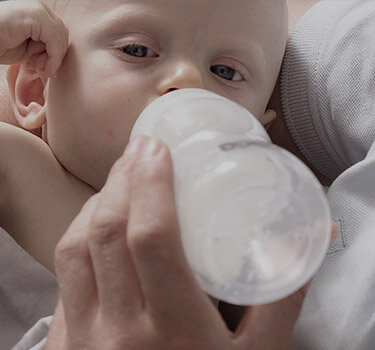Are you pregnant and intend to breastfeed? Or maybe you have already given birth and are looking for information because of problems with breastfeeding your baby? Sometimes, something that seems natural is not easy, particularly at the beginning. Learn how to latch the baby on correctly.
Consultation: Agata Serwatowska-Bargieł Ph.D., International certified lactation consultant (IBCLC), neonatologist
You should know that correct latching on of the baby is not only a question of instinct, but also of technique. Learn how to do it and then, exactly as in numerous other cases, when you overcome initial hurdles, you will enter a long and joyful period of natural feeding.
We wish every new mum a smooth and optimal beginning of breastfeeding: natural birth, a mum and her baby in good condition and health, the baby placed on the mum's belly immediately on his arrival, long kangaroo care during which the newborn seeks a breast, starts to suck and falls asleep.
However, life writes various scenarios... A woman can give birth naturally or have a C-section, or a baby, due to his condition, cannot be placed on her belly but must be placed in an incubator instead. Sometimes (as each childbirth, both by a C-section or natural is a hazardous situation for a woman), immediate latching on is not possible due to mother's condition after birth. That's life... Well, this is not a time for regret and being upset. Now your task is to stimulate and maintain lactation, and to provide your baby with first milk he needs so much. And when the danger passes and you can be together, you will face another task - learning how to suck correctly.
First milk coming from your breast, sometimes already in the last weeks of your pregnancy, is called colostrum. Its composition is different from that of mature milk, produced later. It contains more proteins, a rich set of mineral salts, vitamin A and, what cannot be overestimated, class A immunoglobulins. Amongst the others, these antibodies colonize infant's digestive tract, support maturing of the immune system, and reduce the risk of allergies.
Therefore, it is very important that your baby gets this milk. Sometimes, when you are bed-ridden, and the baby is in an incubator, this is a midwife's role to get a few drops of colostrum from your breasts and give them to your baby on a spoon, with a syringe or a drinking cup. When they do not approach you, request that and ask for it.
We would like to assure you that these several drops will suffice. Do not be upset that you only have so little milk, and the baby is hungry. During the first 24 hours, your baby needs only about half a teaspoon of milk during one feeding. The importance of giving first milk, colostrum, to the baby lies not so much in feeding him, because your baby is still full of what he absorbed during his fetal life, but in colonizing his digestive tract with beneficial bacterial cultures and providing him with valuable antibodies.
Technically, a term "latching on" is a very precise one, as actually you do not give a breast to the baby, but "attach" the baby to your breast.
Your baby has been in this world for a few hours, the first unforgettable moments of kangaroo care are over, or you can finally be together after a forced separation - the time has come for the first latching on to a breast for feeding. Remember, your baby still does not need large amounts of milk, as its stomach is very tiny.
The first comfortable feeding position is selected depending on the mum's condition.
The woman lies on her side, with her head resting on pillows. The baby is facing its mum, in a tummy-to-tummy position, his head rests in the crook of the mum's elbow, and her forearm supports the baby's back.
When you find it difficult to lie on your side, or cannot roll over after a C-section and must lie on your back. In these situations, a lying position on your back will be helpful, with the baby placed along or across your belly. The baby is placed on you, with his head on your breast, and you support him by embracing him with your hand to keep him stable. When you find it difficult to move to place the baby correctly in this position, ask a midwife for help.
Sit comfortably in an armchair or on a sofa, with your back straight and supported. You should hold your baby with his head in the crook of your elbow, supporting his bottom with your hand, with the baby's tummy touching your belly.
In this position you can easily maneuverer the baby's head, so feed in this position whenever you can, when you start to learn how to breastfeed or when the baby grasps the breast incorrectly in other positions. Sit comfortably with your back straight. Place a rolled pillow on the side of the breast you are going to give to the baby. Place your hand under the baby's head and neck, and your forearm under his back, so the baby is turned to you with his tummy, and his legs are under your arm. Put the baby onto your breast, ensuring his head and back form a straight line.
Once again: you can learn how to correctly latch your baby on, as it is a matter of your technique and not your instinct. Below there is a step-by-step instruction, emphasizing the points you need to pay attention to:
Take the breast in your hand, supporting it with four fingers from underneath, and the thumb above the nipple. Your fingers should be outside the areola.
Encourage the baby to open his mouth wide, by delicately touching his lips with the nipple. Then he should open his mouth wide and move his head, seeking food.
When the baby opens his mouth, direct the baby's head, with his open mouth aiming at the breast (not the other way round).
When the baby grasps the breast correctly:
whole nipple with the areola is in his mouth;
tip of the baby's nose and his chin touch the breast in a perpendicular position;
both baby's lips are turned out;
his cheeks are full and rounded, not sucked in during suckling;
baby's tongue is under your nipple, and you can feel it pulling the nipple from the bottom, with scooping movements.
You can hear the baby swallowing milk.
You can notice changing suckling pattern. At the beginning, the baby sucks quickly and shallowly, and then slowly, strongly, and rhythmically.
Breastfeeding should not hurt. However, you can feel a tingling sensation in your breasts, related to the oxytocin spasm supporting milk letdown.
When you have to stop feeding for any reasons (you feel pain, you must do something, the baby has fallen asleep with your breast in his mouth), insert your little finger delicately into the corner of the baby's mouth, press the breast delicately to remove air, and take the nipple out.
You are expecting a baby and want to breastfeed, or maybe you have already started this exceptional adventure, but your head is full of questions and doubts, as in many cases it is not an easy and problem-free task. We will ...
Can I breastfeed after a C-section? Will I have milk? Will my baby know how to suck?" These questions often trouble future mothers with an elective C-section. We would like to convince you that a C-section is not an obstacle ...
A popular opinion says that breastfeeding is a great sacrifice on a woman's part for a baby's good. The truth is this way of feeding is advantageous not only to the baby but also to the breastfeeding mum.
Many mums worry whether their breasts produce enough milk. The doubts usually occur when a child often cries, demands breast more frequently than usual, breasts become soft and you do not need breast pads anymore. However, ...
Breastfeeding is a wonderful gift that nature gave to women. A gift both for the child and for mothers themselves. Explore the benefits of breastfeeding.
To achieve successful beginnings of breastfeeding, you will need self-confidence, patience, support from the loved ones and getting acquainted with a handful of tips that will allay fears and doubts.
What is the difference between colostrum and the proper milk? How to latch? We ask ourselves these questions at the beginning of feeding. Here you will find the answers.
Although many mums worry about it, breastfeeding does not make breasts unattractive. Just take care of them properly choosing the appropriate underwear, cosmetics and products for lactation hygiene.
During feeding the baby sometimes swallows air that accumulates in the digestive tract and can cause colic, bloating and posseting. Therefore, after each feeding you should encourage your child to burp. We show 3 burping ...
The initial failure of breastfeeding may be associated with sore, inverted or flat nipples. Explore solutions to help yourself overcome these problems.

